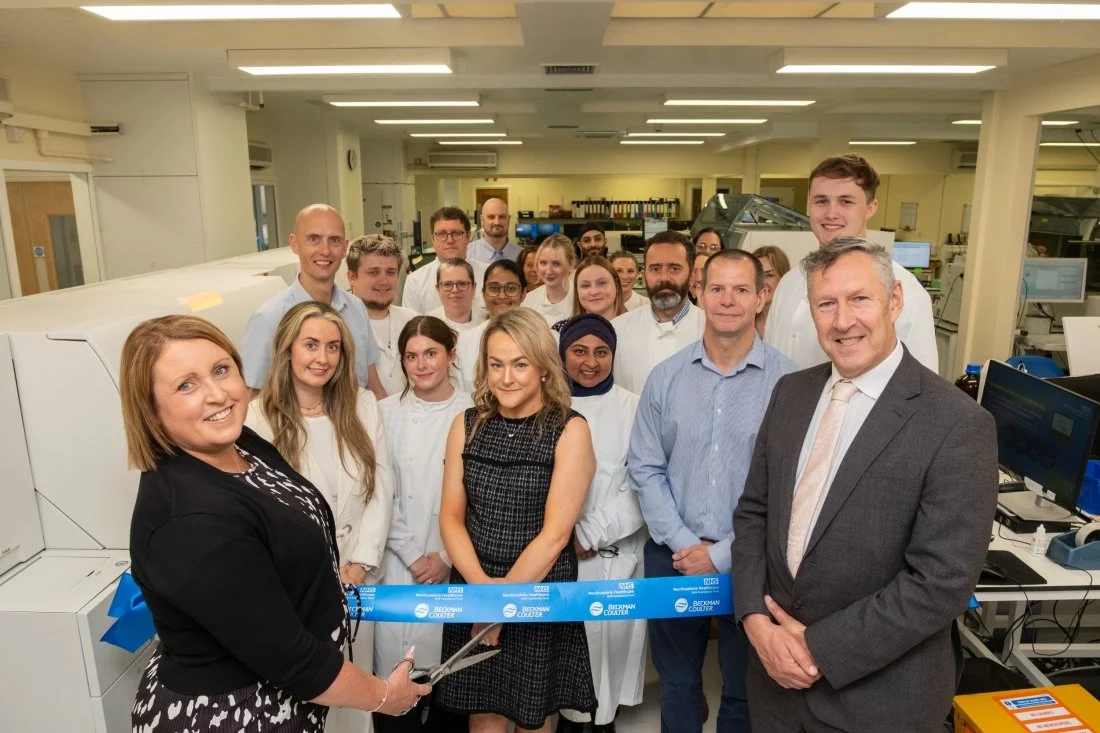Refurbishing a Lab While Keeping Diagnostics Running
Staff from Northumbria Healthcare NHS Foundation Trust toured the newly refurbished pathology laboratory at North Tyneside General Hospital on Biomedical Science Day, marking a key step in the trust’s phased transformation while maintaining uninterrupted diagnostic services. Image: Courtesy of Northumbria Healthcare NHS Foundation Trust
To mark Biomedical Science Day on June 5, Northumbria Healthcare NHS Foundation Trust invited staff from across its services to step inside its newly refurbished pathology laboratory at North Tyneside General Hospital (NTGH) in the north of England. While the event celebrated a significant milestone, the project also offered valuable lessons for other healthcare providers planning similar upgrades—especially when working within live clinical environments.
Pathology underpins approximately 85 percent of clinical pathways in the UK, and Northumbria's pathology service conducts over 12 million tests annually across four sites. With testing equipment provided by Beckman Coulter, the trust operates labs at NTGH, Northumbria Specialist Emergency Care Hospital (NSECH), Hexham General Hospital, and Wansbeck General Hospital.
Building while operating
The recent NTGH refurbishment was more than a facelift—it marked the beginning of a broader transformation. "This was both a major optimization and a strategic enabling project," explains Debra Padgett, clinical pathology lead and lead healthcare scientist at Northumbria Healthcare NHS Foundation Trust. "It modernized our NTGH service while preparing the foundation for our next major step—the new-build Blood Sciences laboratory at NSECH."
"Rather than a standalone upgrade, this work represents a clear first phase of transformation. It gave us the operational and cultural shift needed to begin moving from discipline-specific labs toward a fully consolidated, future-focused service model," Padgett adds.
A significant challenge was carrying out a major refurbishment in a fully functioning diagnostic lab. The team had to work within a strict 12-week timeline and a fixed budget, all while ensuring services continued without disruption.
End-user input, early and often
One key to success was involving the right stakeholders early. "We actively involved end-users from the start," Padgett says. "Input was gathered from biomedical scientists, clinical leads, and operational staff across both chemistry and hematology to understand how workflows could be improved—not just for the current setup at NTGH, but with an eye toward our future integrated service at NSECH."
The input had a direct impact on layout decisions, analyzer placement, implementation timelines, and process alignment between disciplines. That focus on cross-team collaboration also supported a cultural shift—an essential takeaway for others considering the consolidation of traditionally siloed lab services.
"Their feedback influenced key decisions around layout, analyzer deployment, timelines for implementation, and how to better align working practices across disciplines," says Padgett. "This refurbishment was not just about improving the current space—it was about starting the journey to a unified Blood Sciences model."
Maintaining uninterrupted service was another major challenge. "No significant downtime occurred," Padgett says. "The refurbishment was delivered in phases supported by fabulous project management from both Beckman Coulter and Northumbria, working collaboratively to maintain full diagnostic service delivery. Operations continued throughout, with temporary adjustments and close coordination between teams, estates, external contractors, and Beckman Coulter. This project also acted as a live test environment, helping us better understand operational needs ahead of the consolidated service at NSECH, where we'll be bringing chemistry and hematology together into one lab."
Strategic framing
Padgett emphasizes the importance of setting realistic goals early in the process. "We also had to manage expectations: this refurbishment wasn't the endpoint, but a transitional phase," says Padgett, noting that this approach can sometimes be more complicated to communicate than a 'final' design plan.
Complex construction was required—including the removal of a wall between two lab areas—all while protecting sensitive equipment and maintaining safe, clean conditions. To mitigate risk, the team restricted major work to weekends, which required precise planning and tight coordination.
Involving end-users early and fostering cross-disciplinary collaboration proved essential to navigating complex lab refurbishments while maintaining uninterrupted operations. Image: Courtesy of Northumbria Healthcare NHS Foundation Trust
Choosing refurbishment over new build allowed for quick wins while paving the way for larger changes. This refurbishment was never the end plan—instead, "it was a critical enabler," Padgett says. The refurbishment project enabled the lab to upgrade its existing infrastructure within a short timeframe, align processes and systems in preparation for NSECH, support cultural integration between the chemistry and hematology teams, and pilot equipment and workflow changes that will inform the design of the new lab.
The collaboration with Beckman Coulter helped provide a valuable upgrade in its own right, says Padgett, "but is also part of a wider optimization of our services across the sites."
"It delivered tangible improvements while giving us the space and time to plan the larger-scale transformation at NSECH, where we will bring all Blood Sciences under one roof in a purpose-built environment."


